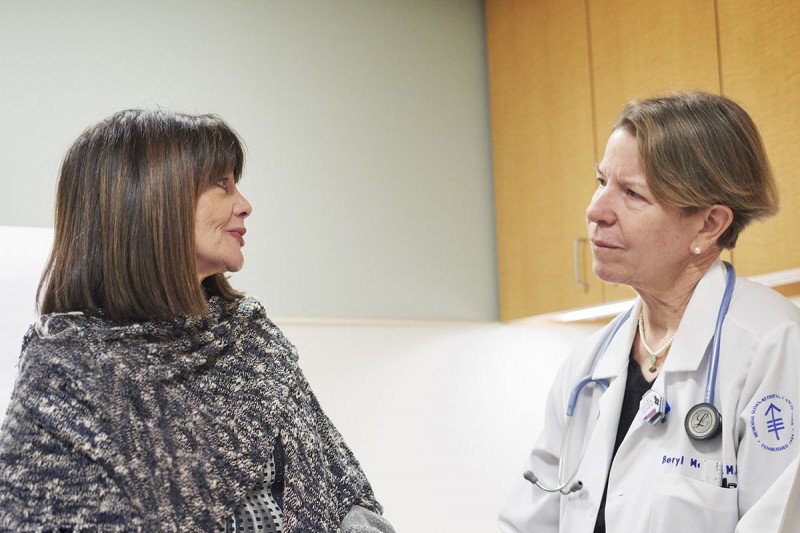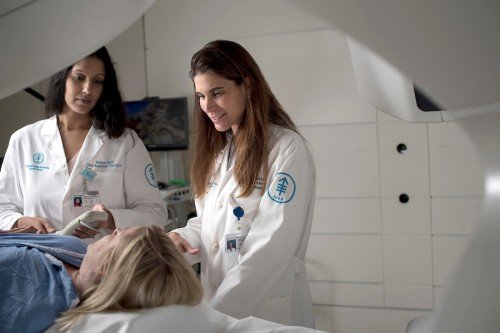
Women with early-stage breast cancer are increasingly choosing breast-conserving surgery (also called a lumpectomy) to remove tumors. Unlike a mastectomy, which removes the entire breast, a lumpectomy involves taking out only the tumor and a small amount of healthy tissue around it. This procedure allows women to keep their breast and avoid reconstructive surgery.

Breast-conserving surgery is usually followed by radiation treatments to destroy any remaining cancer cells in the breast and surrounding lymph nodes. Studies over the past 30 years have shown that a lumpectomy followed by radiation therapy in women with stage I or II breast cancer is likely to be as effective as a mastectomy at preventing the disease from coming back (recurrence).
“Breast-conserving surgery is an individual choice, depending on a person’s personal preferences and comfort level with risk,” says Beryl McCormick, Chief of the External Beam Radiotherapy Service. “Some women with breast cancer — especially if they are diagnosed young — still want a mastectomy, or they even have both breasts removed if they are anxious about the cancer returning. But I think the word is getting out, especially from our surgeons, that the outcome is the same whether or not you have all your breast tissue removed.”
Women who opt for breast-conserving surgery also have a choice about the type of radiation therapy they receive. Once again, studies have shown that, in many people, a less-extensive treatment can work just as well at preventing cancer recurrence.
Partial-Breast Radiation Therapy Is a New Option after Surgery
The standard radiation therapy approach after a lumpectomy has been to target the entire breast. The method is called whole-breast irradiation. It is typically given every day for four to six weeks. In recent years, researchers have investigated whether women with early-stage breast cancer who undergo a lumpectomy could instead receive accelerated partial-breast irradiation (APBI). This involves daily treatment of a smaller part of the breast over a shorter time period, typically one to two weeks.
In December 2019, two large studies published in The Lancet suggested that APBI after a lumpectomy is appropriate for many women with early-stage breast cancer. Dr. McCormick was a co-author on one of the studies, which reported results from a randomized phase III trial comparing whole-breast radiation therapy with APBI in more than 4,000 women with early-stage breast cancer. Although the study showed a slightly higher increase in the cancer returning with APBI, the overall risk was low.
“The main takeaway from this study is that for most patients, partial-breast radiation is pretty much equivalent to whole-breast radiation,” she says. “Some of the younger patients did not do quite as well receiving partial-breast radiation, and if the tumor was larger, they did better with whole-breast radiation. But the differences overall were very small, and I think patients should feel they can pick and choose after talking with their doctor.”
The other Lancet study, reported by researchers in Canada, also showed APBI to be as effective as whole-breast radiation. One interesting finding from that randomized trial, Dr. McCormick explains, is that women who received APBI were slightly more likely to experience cosmetic side effects, such as thickened skin or discoloration.
“At MSK, we’ve found that we can reduce these cosmetic problems with APBI by spreading the typically ten daily treatments over a two-week period,” she says.
Regardless of the radiation therapy approach, Dr. McCormick says most women are happy with their decision to have breast-conserving surgery plus radiation rather than a mastectomy. The radiation treatments are not difficult for most patients. They can go to work and carry out normal activities without visible physical side effects, she notes.
Age Is a Major Factor in Determining What Type of Radiation Therapy Women Should Receive
The good news is that both whole-breast and partial-breast radiation therapy after a lumpectomy are effective in preventing early-stage cancers from recurring, according to Dr. McCormick. But partial-breast radiation therapy may not be right for younger women who have not gone through menopause. Breast cancer in these women tends to be more aggressive and less likely to respond to treatments.
“I’m very comfortable offering partial-breast irradiation to older women,” Dr. McCormick says. “It’s a good choice for people who are interested in a short course of radiation and are not as worried about cosmetic issues.”
Even for older women, though, it’s important to look at all the individual factors, she explains. Women should talk to their doctor in order to make the best choice.



